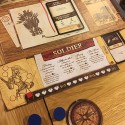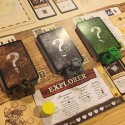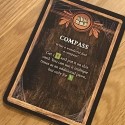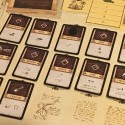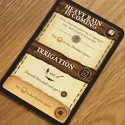‘Robinson Crusoe’ Board Game Review

Whilst we love reviewing board games based on movies and TV series here at Nerdly, there are relatively few based on eighteenth century literature like Robinson Crusoe. Aside from the out of print Fury of Dracula and Sherlock Holmes: Consulting Detective which are both based on later novels, I’m not even sure I can name another game based on a historical piece of writing. Clearly I’m open to suggestion and there are probably hundreds, but as always it’s a matter of not knowing what you don’t know.
In any case, Robinson Crusoe is now a relatively old game, having first been released back in 2012, yet nonetheless it still ranks well inside the top fifty of several most popular lists on BoardGameGeek. Robinson Crusoe is the brainchild of Portal Games’ Ignacy Trzewiczek, the man who went on to create First Martians, a cooperative survival game that we reviewed earlier this year. First Martians is a heavy, complex beast that I struggled to come to terms with for some time (although I got there in the end) and since it was based on Robinson Crusoe, I came into this review with an amount of trepidation.
I needn’t have worried, however, because whilst Robinson Crusoe has similar mechanics to First Martians, it is somehow a much less daunting experience. The game is played by one to four players, with one or two non-player characters (a native known as Friday and a Mastiff called Dog) added to the mix at any count less than three. Every player character has a number of different skills and a unique invention, so depending on which characters are being used and what scenario is being played, the game could be more or less difficult.
On that note, the game features seven scenarios out of the box, ranging from a basic learning game to a range of increasingly more demanding challenges. Regardless of what demands a particular scenario might make of the players, there will always the challenges of Island life to contend with. Exploring new locations, gathering enough food and resources to sustain the group and constructing sufficient shelter to survive bad weather must be considered alongside whatever the main objective might be.
In game play terms, this manifests itself as a series of phases, beginning with the gathering of supplies, then moving through a worker placement action round and then a resolution phase. Each character has two available actions per round and using any two to undertake the same action will result in an instant, automatic success. Using one action will force the player to roll dice against the associated action, but doing so comes with risks and potential rewards (such as injuries, predator encounters, gaining determination tokens and more) as well as the chance for success. Especially in later scenarios, the players simply won’t have time to double down on every action, so striking a balance between risk and reward is crucial.
Available actions include exploring new hexes to expand the board, gathering resources from previously explored spaces, building inventions and shelter buildings and hunting for animals. There are a few other specific actions that you might find on the scenario board and there are also events to resolve. Events are drawn every turn and usually come with an immediate effect and a worse one if you can’t resolve the event. There are often bonuses for doing so as well, but as always choosing to resolve an event is a matter of prioritisation. After the action round is complete, players may take damage if they don’t have a shelter, but even if a shelter and a palisade have been invested in, a dice roll at the end of each turn might tear them down. Predators and bad weather can both take them down and harm the players, especially if there’s no shelter to begin with. As a result of all these possible actions and consequences, the game has a great way of driving constant and challenging decision making. Sure, this can result in a bit of analysis paralysis among new players, but it also leads to very rewarding game play.
I mentioned earlier that taking actions with just one pawn can result in unknown consequences, which is mostly to do with the adventure decks associated with each kind of action. These decks are vast and filled with interesting circumstances that change the game in unexpected and highly variable ways. Similarly, exploring the island can lead to lost treasure, ancient curses and much more, so replay value in Robinson Crusoe is very high. Different combinations of characters and starting items change things even further, especially since this is a game all about maximising the efficiency of each decision.
Whilst I enjoyed playing Robinson Crusoe at all player counts, I found it unusually fun as a solo experience. Using Friday and Dog in addition to a player character adds a different kind of challenge and conjures up some really thematic imagery. Dog can only hunt or explore, whilst Friday has skills similar to the players, but with much less health and no special ability. Playing solo is very fast and it’s a really good way to learn the game, whilst in multiplayer, you’ll feel a real sense of camaraderie.
Despite some nervousness coming into Robinson Crusoe, I think my experience with First Martians made it a breeze. The manual is well made, clear and filled with examples but to get up to speed even quicker, there’s an excellent Watch it Played video from Rodney Smith. Other components are excellent and there are lots of them in wood, thick cut cardboard and quality card stock. Robinson Crusoe is at least a midweight experience, but it has enough theme to make it highly appealing and once you’ve learnt the rules, it’s easy enough to teach. A great cooperative game with a unique concept that I think anyone can enjoy.
**** 4/5
You can buy Robinson Crusoe online at 365Games.co.uk, or at your local games store. Don’t know where yours is? Try this handy games store locator.


